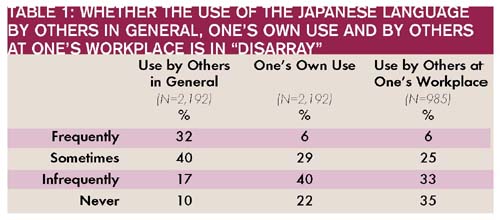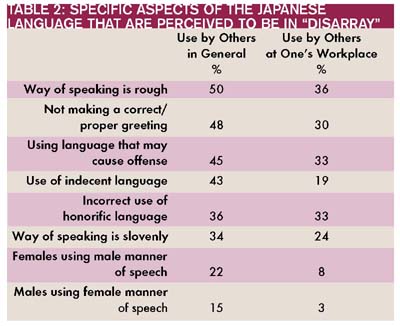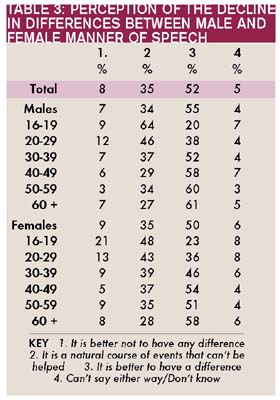Is the Japanese Language Going to the Dogs?
Back to Contents of Issue: April 2002
|
|
|
|
by William Hall |
|
Young people today don't know how to write a letter, use the correct form of address, or carry on a proper conversation. The language is going to pot. Refrains such as this are heard from the elder generation in all countries, and Japan is no exception. But how valid are such claims?

In January 2001, the Cultural Affairs Agency conducted a study entitled Kokugo ni Kansuru Yoron Chosa (Opinion Poll in regard to the Japanese Language), with the subtitle "Usage at Home and at the Workplace." The aim of the study was to obtain an understanding of the current state of thinking about the Japanese language by Japanese citizens, particularly in light of the social changes occurring in modern Japan, and to provide input for the planning of national language policy. The study involved personal interviews with a nationwide sample of 3,000 randomly selected Japanese nationals age 16 years and above. A 73 percent completion rate was achieved, yielding 2,192 completed interviews (1,068 males and 1,124 females). 
Respondents were initially asked their degree of interest in the Japanese language in regard to topics such as the choice of words, the manner of speaking, the way of writing and the like. 73 percent stated that they were "very/somewhat interested," a figure unchanged from that obtained in an earlier survey conducted in 1993. Among the particular topics of interest mentioned, the top two were "choice of words and manner of speaking in daily life" (75%) and "the use of keigo" (the honorific form of the language) (57%). (Competency in the use of honorific Japanese necessitates knowing a virtually separate vocabulary within the Japanese language, particularly with verbs. The flip side of keigo is kensongo, the humble form of the language, which also has its own vocabulary, once again particularly with verbs. The correct use of keigo and kensongo is driven by the degree of distance/familiarity in the relationship between the persons involved). Other topics mentioned were "etymology/history of words" (24%), "use of kanji" (Chinese characters) and "manner of writing" (24%), "pronunciation and accent" (23%), "new words/ 'in' words" (18%) and "the influence of technology on the Japanese language" (15%). Respondents were then asked whether they felt that the use of language by the people they came into contact with in daily life or saw on TV, et cetera, was midarete iru. In Japanese midarete iru has the meaning in this context of "deviating from the norm," "inaccurate" and, to some extent, "slovenly." For simplicity's sake, "disarray" will be used as the English equivalent. Respondents were asked a similar question in regard to whether they felt, in their normal daily life, that their own use of the language was in "disarray." Additionally, those respondents who held a job in a company were also asked whether the language used by fellow workers at their workplace was in "disarray." The responses to these questions are shown in Table 1 above. 72 percent of respondents considered the general use of the language by others to be "frequently/sometimes in disarray," in contrast to only 35 percent with the same feeling about their own use of the language and 31 percent by others at the workplace. While a relatively high level of self-evaluation of one's own usage is perhaps to be expected, the low percentage of perceived inaccurate usage at the workplace shows the importance of correct form in Japanese business and the significant amount of training conducted in this regard. When cross-tabulated by age, the percentage of younger respondents age 16-29 who considered the use of the language to be frequently in "disarray" (15%) was less than half that of those age 30 years and above (30+%). Those who felt that the use of language was in "disarray" were asked what specific aspects they considered to be in "disarray." (See Table 2.) A review of the responses to this question provides a clear demonstration of the importance of form, concern about 'face' and the role of politeness in Japanese society. The top five highest-scoring responses for "disarray" in general usage are examples of this -- "way of speaking is rough" (50%), "not making a correct/proper greeting" (48%), "using language that may cause offense" (45%), "the use of indecent language" (43%) and "the incorrect use of honorific language" (36%). These were also important issues at the workplace as well, although the percentage scores were lower. Two other responses -- "women using a male manner of speech" (25%) and "males using female manner of speech" (15%) -- highlight another issue in Japanese, to wit, that males and females may use different intonations and even words when discussing the same topic. For example, to say "I" in Japanese, depending upon the situation and the degree of familiarity in the relationship, Japanese males will normally use watakushi, boku, or ore and in formal writing might use shosei. In spoken Japanese, a female will normally use watakushi, watashi or atashi. Each of these above choices for the pronoun "I" is grammatically correct and each means "I," but one or other of these may not be correct when used in the wrong context. In general, for all the topics mentioned above, women tend to be concerned more than men, by a margin of some 5-10 percent. Also, respondents age 16-29 were less concerned with these aspects than their elders. In regard to the issue of male/female speech, a specific question was asked as follows. "It has been said that the differences in male and female manner of speaking is becoming less. Please tell me which answer from among those given is closest to your opinion." As can be seen in Table 3 below, more than half the population (52%) considers that it is better to have a difference between male and female speech, with males (55%) feeling stronger in this regard than females (50%). Note also the high percentages of young males and females age 16-29 who, in contrast to those age 30 and over, consider that a decline in the difference is natural. A similar question was asked in a study conducted in 1994 and in the intervening years the percentage of those considering that it is better to have a difference increased by 8 percent (from 44% in 1994 to 52% in 2001). The reasons for this increase are not clear -- a reversion to a desire for clearer male/female role definition in a time of recession? Or, more simply, this change is a reflection of the increased weight of the (more conservative) older population within the total Japanese population. Respondents were asked whether they use, in their normal speech, certain phrases which can be considered as variations from standard Japanese. For example, the use of ii jan instead of ii ja nai, or yappa so ka instead of yahari so ka. While these differences will not be meaningful for a non-speaker of the language, the point to note here is the very large difference in usage patterns between the younger generation and their elders. In both cases, some 60-70 percent of respondents age 16-29 use such expressions compared to less than 20 percent usage among those 50 and over. The study also covered other issues including the influence of TV, video games and comic books on the language used by children, the acceptability of different grammatical forms of expression, knowledge of proverbs and approaches to Romanization of Japanese words. Space does not permit coverage of these topics, but certain undercurrents do emerge from the overall study. The Japanese language is a complex one with three writing systems (See "Japan Studies," May 2000), with an arcane approach to reading personal and place names that might justifiably qualify as the eighth wonder of the world (See "Japan Studies," May 2001) and, as we have seen above, replete with issues of correct usage of honorific speech, male and female speech, appropriate terms of greeting and such like. 
One finding is that less than 10 percent of the total population thinks that it would be better if there were no discrete male/female manners of speaking, with the majority of the population considering it to be preferable to have discrete male and female manners of speaking. Language does not appear to be a women's lib issue in Japan. Another finding is that the younger generation appears less willing to follow the traditional emphasis on form, face and politeness in their speech. Given the rapid aging of Japanese society, the younger generation forms an increasingly smaller percentage of the total population and so it will be interesting to watch how this difference in language usage develops. In particular, the use of computers, mobile phones, PDAs and other such IT products, which are used primarily by the young, will have an impact on the language. This latter topic on the influence of IT products on the language will be the focus of next month's column. @ William Hall williamh@isisresearch-jp.comis president of Isis Research Japan Ltd., which provides market research and consulting services in Tokyo. |
|
Note: The function "email this page" is currently not supported for this page.






